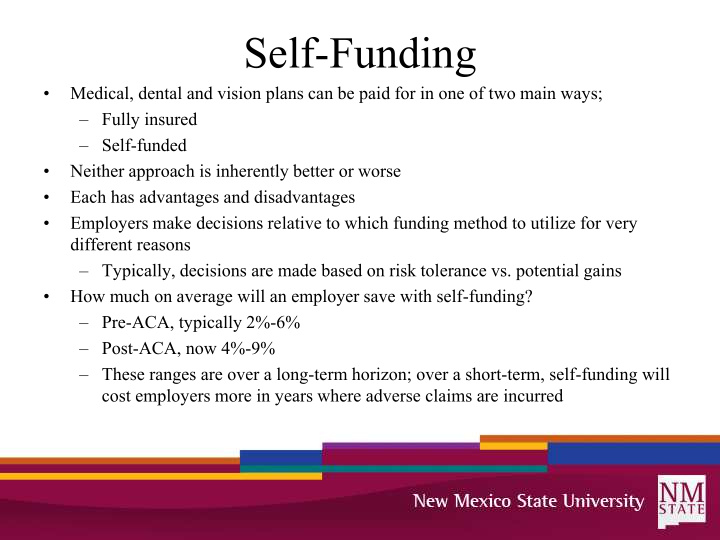



Self-Funding • Medical, dental and vision plans can be paid for in one of two main ways; – Fully insured – Self-funded • Neither approach is inherently better or worse • Each has advantages and disadvantages • Employers make decisions relative to which funding method to utilize for very different reasons – Typically, decisions are made based on risk tolerance vs. potential gains • How much on average will an employer save with self-funding? – Pre-ACA, typically 2%-6% – Post-ACA, now 4%-9% – These ranges are over a long-term horizon; over a short-term, self-funding will cost employers more in years where adverse claims are incurred
Self-Funding Cash Flow Timing at Beginning and End • First year costs are “immature” due to lag in claim payments (first year medical costs may be 18% to 20% lower than a mature year) resulting in approximately 10 months of incurred and paid claims – Reduction in first year expense will help “fund” reserves (Incurred But Not Reported claims – IBNR) – Self funded plan sponsors must book this liability • Employer gains benefit of float (weekly/monthly funding and IBNR) • Second year costs are mature (i.e., twelve months of paid claims and expenses) Reserve Development 3 Mos. 12 Mos. 24 Mos. 36 Mos. (Term) Effective date of newly self-funded plan
Pros and Cons of Self-Funding PROS CONS Cash flow advantages: Acknowledged claim experience: • Pay as you go approach • Worse than average claim experience • Maintaining reserves • A group with bad demographics may do better under fully • Utilizing the float on claim payments insured arrangement Cost savings: Budgeting the program: • No state premium tax • There will be monthly fluctuations • No ACA premium tax • A strictly enforced budget could be an issue • Interest on funds otherwise held by the • PCORI and transitional reinsurance fee no longer bundled insurer into the fully insured rates • Avoid costly state mandated benefits Plan control: Increased employer involvement: • Easier monitoring of claims costs • Verifying eligibility • Claims data provided • Maintaining banking arrangements • Additional HIPAA responsibilities • Increased HCR reporting and filling • Essential Health Benefits definition Plan design flexibility: Terminating the program: • Not bound by state mandates • Self-funded back to fully insured is a double whammy; • Customized benefits for your employees paying run-out plus paying fully insured premium Stability of self-funding: Fiduciary Responsibility: • Employers rarely return to fully insured • Employer may need to assume full liability; although • Claims are claims: why pay more than Fiduciary options are available through TPAs what your claims are?
Pros and Cons Impact to Active Employees and NMSU PROS CONS Employees Employees • More choice • Provider disruption • Potential cost savings • Network access • Can choose how to spend their own money • Change in plans/benefits NMSU NMSU • Potential cost savings • Communication • Can design own benefits • Potential for push-back from employees • More flexibility • Fiduciary liability • Ease of administration • Establish reserves • Cash flow • Trend mitigation • Better control of healthcare cost management • Control over impact of excise tax April 19, 2016
Recommend
More recommend